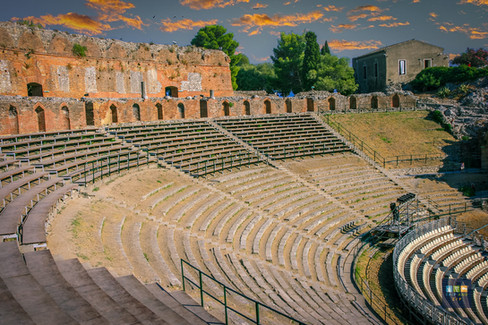Layers of History and Beauty in Taormina
- Trip And Zip

- Aug 11, 2011
- 3 min read
Updated: Mar 7
Set high above the Ionian Sea, Taormina is one of Sicily’s most captivating towns — a place where history, architecture, and modern life come together in a setting as dramatic as the coastline below. Its strategic position made it a crossroads of civilizations, each leaving its mark on the town’s architecture, culture, and atmosphere.


Taormina’s history stretches far beyond its medieval chapter. The town had already flourished under Greek, Roman, and Byzantine rule, each era leaving its own architectural and cultural imprint. When the Normans took control of Sicily in the 11th century, Taormina became part of their expanding kingdom — a realm where Western power blended with Arab artistry and Byzantine refinement.
The town’s medieval identity took shape under the Norman kings, whose rule brought a remarkable blending of artistic traditions. The Normans, themselves descendants of Viking settlers, had absorbed the architectural influences of the lands they conquered — particularly the Islamic craftsmanship they encountered in Sicily.
The result was a distinctive Norman-Arab-Christian fusion, which can still be seen in Taormina’s palaces, churches, and public buildings. Arched windows, intricate stone carvings, and courtyards filled with Mediterranean plants all reflect this unique synthesis of cultures, something that has always fascinated me when visiting.

This architectural dialogue between Western power, Byzantine refinement, and Islamic geometric beauty gives Taormina an identity unlike any other in Italy. Walking through its historic center is a journey across cultural frontiers, where contrasting styles harmonize rather than compete.
The heart of modern Taormina is the Corso Umberto, the lively main street that stretches through the town, connecting Porta Messina at one end to Porta Catania at the other. These ancient gates, once part of the town’s defensive walls, now stand as welcoming markers between history and modern life. The Corso itself is a vibrant blend of boutiques, cafés, historic buildings, and hidden courtyards, where every step offers something new to admire — whether it’s a centuries-old balcony or a sleek fashion display.




Taormina’s buildings and squares reflect the same rich layering of cultures that shaped its history. Elegant palazzi with Norman foundations, Baroque churches, and stone facades with Moorish arches stand side by side, blending influences from across the Mediterranean. The Piazza IX Aprile, with its stunning sea views and checkerboard pavement, is the perfect example — a stage where history, architecture, and daily life come together. In every corner, from sunlit balconies to shaded courtyards, Taormina’s unique architectural dialogue reveals itself, making even a simple stroll feel like stepping through centuries.
What always draws my attention in Taormina is the way life unfolds along the Corso — elegant but effortless, traditional yet modern, a place where both visitors and locals become part of the scenery.
There’s a natural sense of style here, not only in the way people dress but in how the town itself presents its face to the world. Fashion feels inseparable from the setting, with linen shirts and flowing dresses blending into the soft stone and warm light, while in the evening, understated elegance takes over as tables fill up for aperitivo.

Above it all, both literally and symbolically, stands Taormina’s ancient Greek theatre, one of the town’s most extraordinary legacies. Built more than 2,000 years ago, the theatre sits on the edge of the hillside, its semi-circular seating carved directly into the rock. From the upper rows, the view stretches across the rooftops to the sea, and on clear days, Mount Etna dominates the horizon. Few ancient sites offer such a perfect balance between natural beauty and architectural mastery — a harmony that reflects the same blending of cultures that shaped Taormina itself.
Taormina doesn’t rely on a single identity. It carries its past with confidence — Greek, Roman, Norman, and Baroque — but never feels like a museum. It’s a place where history enriches the present, and where the simple act of walking a street or standing at a viewpoint connects you to centuries of life, creativity, and cultural exchange.



























































Comments